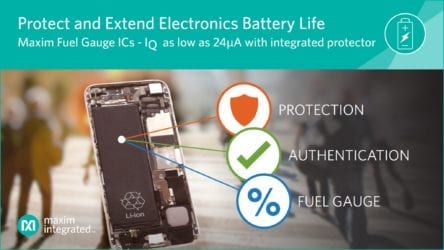Designers concerned about battery safety now have access to the most advanced battery protector with integrated fuel gauges from Maxim Integrated Products, Inc. (NASDAQ: MXIM).
The newest 1-cell, pack-side ICs in this portfolio are the MAX17301 and the MAX17311, which offer the most configurable settings for battery safety in the industry and uniquely allow fine tuning of voltage and current thresholds based on various temperature zones. These ICs also offer a first-of-its-kind secondary protection scheme in case the primary protection fails. This secondary protection scheme permanently disables the battery by overriding a secondary protector or blowing a fuse in severe fault conditions. All ICs in the family are equipped with Maxim’s patented ModelGauge m5 EZ algorithm that delivers highest state-of-charge (SOC) accuracy that on average offers 40 percent better accuracy than competitive offerings and eliminates the need for battery characterization. These fuel gauges also offer the industry’s lowest quiescent current (IQ) – up to 80 percent lower than the nearest competitor, and feature SHA-256 authentication to safeguard the systems from counterfeit batteries.
Conventional battery protectors monitor voltage and current, and in some cases include temperature monitoring. These options make the system vulnerable to unexpected crashes because battery state-of-charge (SOC) isn’t factored in when triggering an undervoltage cut-off decision. The market lacks a solution that allows deeper configuration of voltage or current thresholds based on multiple temperature environments. With a growing market of battery-operated applications, there is a need for a simple, compact solution that protects from unsafe charging conditions that can lead to extensive battery damage including over-voltage, short circuit, over/under temperature and more. Additionally, system and battery designers continue to push the limits of capacity-constrained batteries in order to provide the longest possible run-time without damaging the cell. Currently, there are very few highly-configurable solutions that are still simple to implement. Designers are also looking for a way to protect the system by ensuring that only genuine batteries are used, which can eliminate unexpected shutdowns and crashes caused by potentially unsafe, counterfeit batteries.










